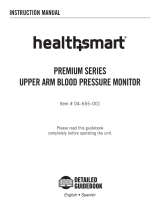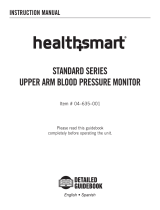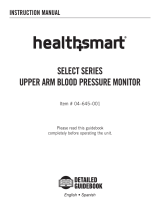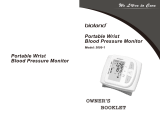Page is loading ...

PREMIUM SERIES
UNIVERSAL WRIST
BLOOD PRESSURE MONITOR
Please read this guidebook
completely before operating the unit.
Item # 04 – 820 – 001
English • Spanish
INSTRUCTION MANUAL

LIMITED LIFETIME WARRANTY
The warrantor guarantees that its Digital Blood Pressure Monitor will be free from
manufacturing defects under normal use for the lifetime of the original purchaser
from the original purchase date of the product. This warranty covers only normal use,
and does not apply for use in any clinical or commercial applications. This warranty
does not cover batteries or other power sources that may be provided with or used
with the Digital Blood Pressure Monitor. The warranty is voided if the Digital Blood
Pressure Monitor product is misused or abused in any manner.
If the Digital Blood Pressure Monitor fails to operate during the lifetime, please call
our Customer Care Help Line at 800-622-4714 and we will try to resolve the issue
as soon as possible. If the warrantor determines the unit failed to operate due to a
manufacturing defect, the unit will be replaced at the option of the warrantor. The
purchaser will be responsible for the prepaid postage and $9.99 to cover return
shipping and insurance. The purchaser must return the original Blood Pressure
Monitor prior to a replacement product being provided. Replacement of the product is
the only remedy covered by the Lifetime Limited Warranty.
This warranty gives you specific legal rights, which vary from state to state. To
be eligible for the warranty, please register your product online within 10 days of
purchase date at www.LiveHealthSmart.com.
This warranty constitutes the warrantor’s only responsibility and obligation to replace
materials or components of the product. We make no other express or implied
warranties, arising by operation of law or otherwise, or any warranty of merchantability
or fitness for a particular use or purpose whether or not the use or purpose has been
disclosed to the warrantor in specifications, drawings or otherwise, and whether or
not the warrantor’s products are specifically designed and/or manufactured by the
warrantor for the buyer’s use or purposes, except for the limited warranty stated
above. The warrantor will not be responsible for any indirect, incidental, special,
consequential, or punitive damages or other loss, including, but not limited to,
damage to or loss of other property or equipment and personal injuries, whether to
purchaser or others. The warrantor shall in no event be liable to the purchaser for any
amount in excess of the cost to replace the product.

1
INDEX
Introduction ................................... 2
Product Identification & Caution ......................... 3
General Blood Pressure Information .......................4–6
Important Information Before Use ....................... 7-8
FCC Statement and EMC Compatibility ..................... 9
Visual BP Guide ................................ 10
Irregular Heartbeat Detection .......................... 11
Battery Installation/ Replacement ........................ 12
Setting the Date/Time ............................. 13
Voice Language Setting ............................. 14
Applying Your Blood Pressure Cuff ..................... 15-16
Heart Spot Technology ............................. 16
Taking Your Blood Pressure Reading ..................... 17-18
Recalling Measurements in Memory ....................... 19
Description of Symbols ............................20-22
Troubleshooting ................................ 23
Care and Maintenance ............................. 24
Product Specifications ............................25-30
Blood Pressure Log .............................. 31

2
INTRODUCTION
Thank you for purchasing an Automatic Blood Pressure Monitor. With proper care and
use, your monitor will provide you with many years of reliable readings.
To achieve the maximum benefit from your blood pressure monitor, we recommend that
you first consult with your physician or trained health care professional.
The method of measurement that your Automatic Monitor uses is called the oscillometric
method. The monitor detects your blood’s movement through the artery in your wrist and
converts the movements into a digital reading. The oscillometric method does not require
a stethoscope, making the monitor easy-to-use. The preformed cuff requires little effort to
apply and is comfortable to wear.
Clinical research has proven a direct relationship between blood pressure in the wrist
and blood pressure in the arm. Because the arteries in the wrist and arm are connected,
changes in wrist blood pressure reflect changes in arm blood pressure. Frequent wrist
blood pressure measurements will provide you and your physician with an accurate
indication of change in your true blood pressure.
People with severe hypertension, severe arteriosclerosis or severe diabetes should
consult their physician about monitoring blood pressure at the wrist.
Blood pressure readings determined with this device are equivalent to measurements
obtained by a trained observer using the cuff/stethoscope auscultation method, within
the limits prescribed by the American National Standard for Electronic or Automated
Sphygmomanometers.
Read all of the information in the operation guide and any other literature in the box before
operating the unit.

3
CAUTION
While taking a measurement, you can stop the inflation or deflation process of the cuff at
any time by pressing the POWER button.
*Instantly compares your readings to standards set by the World Health Organization
(WHO), ranging from optimal health to severe hypertension
PRODUCT IDENTIFICATION
Wrist Cuff
Digital Display
Battery
Compartment
POWER Button (ON/OFF)
MEMORY recall button
Visual BP Guide*
Systolic Pressure
Diastolic Pressure
Pulse Rate
Monitor
Digital Display
AVG
mmHg
kPa
No
(
( )
)
/
User Groups
Low Battery Indicator
Visual BP Guide
Average of Last 3 Readings
Irregular Heartbeat Detector
Time
Date
Systolic
Pressure
Diastolic
Pressure
Pulse
Rate
SET Button

4
GENERAL BLOOD PRESSURE INFORMATION
What is Blood Pressure?
Blood pressure is the pressure that is exerted by blood flowing against the walls of the
blood vessels throughout your body.
Your heart, which is the center of the circulatory system, provides the force for the blood
to flow or circulate. When your heart contracts or beats, the blood is forced through the
blood vessels increasing the pressure. This is the highest pressure in the cycle or what is
referred to as SYSTOLIC BLOOD PRESSURE. In-between beats your heart relaxes and
your blood pressure decreases. This is referred to as DIASTOLIC BLOOD PRESSURE.
This complete series of events which occurs in a single heartbeat is known as the
CARDIAC CYCLE.
Your Digital Blood Pressure Monitor will automatically read your blood pressure and
display both systolic and diastolic readings on the screen. Your systolic will be positioned
as the upper number and the diastolic reading will be the lower number.
(systolic)
(diastolic)
120
80
/
Blood pressure is measured in millimeters (mm) of Mercury (Hg) and is generally recorded
with the systolic pressure (120) listed first and the diastolic pressure (80) listed second.
The numbers are typically separated by a slash mark (/) as shown above.
Both pressure readings, the SYSTOLIC and the DIASTOLIC, are necessary for a physician
to evaluate the status of a patient’s blood pressure.
Please contact your physician for specific information regarding your own blood pressure.

5
GENERAL BLOOD PRESSURE INFORMATION (continued)
What Influences Blood Pressure?
Many factors such as genetics, age, sex, altitude, physical activity, anxiety, muscular
development, certain medications or even the time of day can influence blood pressure.
Influences such as sleep or relaxation decrease blood pressure, while anxiety or exercise
increase blood pressure.
Why Monitor Your Blood Pressure at Home?
A visit to a physician’s office can be stressful for the patient and anxiety is a known factor
in raising blood pressure. This temporary occurrence of elevated blood pressure at the
physician’s office is commonly referred to as “white coat syndrome.”
Whether or not you experience “white coat syndrome,” home blood pressure monitoring
provides you with the opportunity to supplement measurements taken at your physician’s
office. These home readings, when taken over a period of time, can show an accurate
indication of change. Furthermore, your records can assist your physician in evaluating
your health and in making important decisions in the diagnosis and treatment of your
condition. Because of this, it is important to take consistent daily measurements of your
blood pressure.
The variations in your individual readings should only be interpreted by your physician or
a trained healthcare professional.
WHO Blood Pressure Classifications
Standards for assessment of high or low blood pressure, regardless of age, have been
established by the World Health Organization (WHO) as shown in the chart on the
following page.

6
Category
Systolic
(mmHg)
Diastolic
(mmHg)
Color
Indicator
Optimal <120 <80 Green
Normal 120–129 80–84 Green
High - Normal 130–139 85-89 Green
Stage 1 - Mild
Borderline Hypertension 140–159 90–99 Yellow
Stage 2 - Moderate
Hypertension 160–179 100-109 Orange
Stage 3 - Severe Hypertension ≥180 ≥110 Red
Isolated Systolic Hypertension ≥140 <90
140–159 <90 Yellow
160–179 <90 Orange
≥180 <90 Red
This chart is only a general guideline. Contact your physician or trained healthcare
professional to determine your NORMAL blood pressure.
Variations in Blood Pressure
Blood pressure can be influenced by many factors. This change can occur from moment
to moment. Normally, blood pressure is lowest during the sleeping period and rises during
the day. The graph below represents the variations in blood pressure shown over a day
with measurements taken every 5 minutes.
The dotted line represents the
sleep period. The rise in
blood pressure at 1 p.m. (A in
the graph) reflects stressful
occurrence, and at 7 p.m.
(B in the graph), a period
of exercise.

7
IMPORTANT INFORMATION BEFORE USE
1. Blood pressure readings should be interpreted by a physician or trained healthcare
professional, who is familiar with your medical history.
2. Measure your blood pressure in a quiet place. You should be seated and relaxed.
3. Avoid smoking, eating, taking medication, alcohol consumption or physical activity
30 minutes prior to taking a reading. If you are exhibiting signs of stress, avoid
measuring your blood pressure until the feeling subsides.
4. Rest 15 minutes prior to measuring your blood pressure.
5. Remove any constrictive clothing or jewelry that may interfere with the cuff
placement.
6. Keep the monitor stable during measurements. Remain still; do not talk during
measurements.
7. Record your daily readings on the chart provided.
8. Take your readings at the same time, each day (or as recommended by your
physician).
9. Wait a minimum of 15 minutes between readings. The wait time may vary depending
on individual physiological characteristics.
10. This device is intended for adult use only (12 years and older). This Electronic
Sphygmomanometers should never be used on infants or young children. Consult
your physician or other health care professionals before use on older children. Never
use on infants or individuals that cannot express themselves.
11. The inflation or deflation process can be stopped by pressing the POWER button.
12. People suffering from arrhythmias such as atrial or ventricular premature beats or
atrial fibrillation should only use this unit after consulting with their doctor. In certain
cases the oscillometric measurement can produce incorrect readings.
13. People with irregular or unstable circulation resulting from diabetes, liver disease,
arteriosclerosis or other medical conditions, there may be variations in blood
pressure values measured at the wrist versus at the upper arm. Monitoring the
trends in your blood pressure taken at either the arm or the wrist is nevertheless
useful and important.

8
14. People suffering from vascular constriction, liver disorders or diabetes, people with
cardiac pacemakers or a weak pulse, and women who are pregnant should consult
their physician before measuring their blood pressure themselves. Different values
may be obtained due to their condition.
15. To avoid cross contamination, do not share the cuff with an infectious person.
16. Prolonged over-inflation (cuff pressure exceed 300 mmHg or maintained above 15
mmHg for longer than 3 minutes) of the bladder may cause ecchymoma of your
arm.
17. The cuff should not be applied over a wound as this can cause further injury.
18. DO NOT attach the cuff to a limb being used for IV infusions or any other
intravascular access, therapy or an arterio-venous (A-V) shunt. The cuff inflation can
temporarily block blood flow, potentially causing harm to the patient.
19. The cuff should NOT be placed on the arm on the side of a mastectomy. In the case
of double mastectomy use the side of the least dominant arm.
20. Pressurization of the cuff can temporarily cause loss of function of simultaneously
used monitoring equipment on the same limb.
21. A compressed or kinked connection hose may cause continuous cuff pressure
resulting in blood flow interference and potentially harmful injury to the patient.
22. Check that operation of the unit does not result in prolonged impairment of the
circulation of the patient.
23. The monitor might not meet its performance specifications if stored or used outside
the specified temperature and humidity ranges in specifications.
24. If you are taking medication, consult with your physician to determine the most
appropriate time to measure your blood pressure. NEVER change a prescribed
medication without first consulting with your physician.
25. Do not use cell phones and other devices, which generate a strong electrical or
electromagnetic fields, near the device, as they may cause incorrect readings and
interference or become an interference source to the device.

9
FCC STATEMENT AND EMC COMPATIBILITY
This equipment has been tested and found to comply with the limits for a Class B digital
device, pursuant to part 15 of the FCC Rules. These limits are designed to provide
reasonable protection against harmful interference in a residential installation. This
equipment generates, uses, and can radiate radio frequency energy and, if not installed
and used in accordance with the instructions, may cause harmful interference to radio
communications. However, there is no guarantee that interference will not occur in
a particular installation. If this equipment does cause harmful interference to radio or
television reception, which can be determined by turning the equipment off and on, the
user is encouraged to try to correct the interference by one or more of the following
measures:
• Reorient or relocate the receiving antenna.
• Increase the separation between the equipment and receiver.
• Connect the equipment into an outlet on a circuit different from that to which the
receiver is connected.
• Consult the dealer or an experienced radio/TV technician for help.
This device complies with Part 15 of the FCC Rules. Operation is subject to the following
two conditions: (1) This device may not cause harmful interference, and (2) this device
must accept any interference received, including interference that may cause undesired
operation.

10
VISUAL BP GUIDE
The Visual BP Guide, located on the left side of the display,
will identify your reading within a range in accordance with the
guidelines set by the World Health Organization. See the chart
below for reference.
Stage 3 Hypertension
Systolic pressure: ≥180 mmHg
-or-
Diastolic pressure: ≥110 mmHg
Stage 2 Hypertension
Systolic pressure: 160-179 mmHg
-or-
Diastolic pressure: 100-109 mmHg
Stage 1 Hypertension
Systolic pressure: 140-159 mmHg
-or-
Diastolic pressure: 90-99 mmHg
High Normal
Systolic pressure: 130-139 mmHg
-or-
Diastolic pressure: 85-89 mmHg
Normal
Systolic pressure: 120-129 mmHg
-or-
Diastolic pressure: 80-84 mmHg
Optimal
Systolic pressure: <120 mmHg
-and-
Diastolic pressure: <80 mmHg
DIA
SYS
DIA
SYS
DIA
SYS
DIA
SYS
DIA
SYS
DIA
SYS

11
IRREGULAR HEARTBEAT DETECTION
Your digital blood pressure monitor features Irregular
Heartbeat Detection (IHB). If the monitor detects an irregular
heart beat two or more times during the measuring process,
the IHB symbol will appear on the display, Fig. 1. An irregular
heart beat is defined as a rhythm that is either 25% slower
or faster than the average rhythm detected while measuring
systolic and diastolic blood pressure.
NOTE: Please consult with your physician or trained healthcare
professional for further information regarding an irregular
heartbeat if this symbol appears frequently at the end
of a reading.
If an Irregular Heartbeat caused by common arrhythmias is detected in the process
of the blood pressure measurement, the IHB symbol will be displayed. Under this
condition, the Electronic Sphygmomanometers will function, but the results may
not be accurate and it’s suggested that you consult your physician for accurate
assessment.
Fig. 1

12
BATTERY INSTALLATION/REPLACEMENT
Replace the batteries when the Low Battery symbol
appears on the display, Fig. 1, or when the display
remains blank when the POWER Button is pressed.
To change the batteries:
1. Open the battery cover, Fig. 2.
2. Making sure the battery polarity is correct, install two
AAA alkaline batteries.
3. Close the battery cover.
NOTE: It is recommended to remove the batteries if the unit will
not be used for an extended period of time.
The monitor, the batteries and the cuff must be
disposed of according to local regulations at the end of their usage.
Fig. 1
Fig. 2

13
SETTING THE DATE / TIME
Select the appropriate user bank.
1. When the unit is OFF, press the SET button to enter into the
user mode. The User 1 symbol will begin to flash, Fig. 1.
2. Press the MEMORY button to select User 1 or User 2 and
move into the date/time setting. Press SET to confirm.
NOTE: Setting the date / time for User 1 will automatically keep
the same date / time for User 2.
Setting the Date / Time
3. The year will begin to flash Fig. 2.
4. Press the MEMORY button to change until the desired
number appears.
NOTE: To scroll through the numbers quicker, hold down the
MEMORY button.
5. Press SET to confirm.
6. The date followed by the hour and minutes will blink.
Repeat steps 4 and 5 to adjust the date/time setting.
7. After setting the minutes, select the desired date format
by pressing the MEMORY button to switch between
“US” for standard date and 12-hour
formatting or “EU” for standard European
date and 24-hour formatting, Fig. 3.
8. Press SET to confirm.
NOTE: You will now automatically enter into the
Voice Setting and Volume Control mode. Please
see page 14 to continue the setup.
AVG
mmHg
kPa
No
(
( )
)
/
/
Fig. 1
/
/ /
Fig. 3
Fig. 2

14
VOICE LANGUAGE SETTING
Voice Setting
9. Press the MEMORY button to cycle through L1, L2, and OFF as shown in Fig. 4.
L1 - English
L2 - Spanish
L3 - Voice function turned off
The monitor will say the corresponding
language with the displayed language
code.
10. Press SET to confirm.
Volume Control
11. Adjust the volume by pressing the MEMORY button until the desired volume level
is achieved. There are six volume levels to choose from as indicated by the number
of triangles appearing on screen, Fig 5.
12. Press SET to confirm.
NOTE: While in any setting mode, press the POWER button to turn the unit OFF and all
information will be saved. The unit will automatically turn OFF after 3 minutes if not in use
and all information will be saved.
Fig. 4
Fig. 5

15
APPLYING YOUR BLOOD PRESSURE CUFF
Wrist Circumference Range Suitable for 5.3" – 8.5" (13.5 cm – 21.5 cm)
Avoid smoking, eating, taking medication, alcohol
consumption or physical activity 30 minutes prior to
measuring your blood pressure. If you are exhibiting signs
of stress, avoid measuring your blood pressure until the
feeling subsides. Rest 15 minutes prior to taking your blood
pressure reading.
1. Remove any constrictive clothing or jewelry that may
interfere with the cuff placement.
2. You should be seated with your feet flat on the floor.
3. Hold your left arm in front of you with your palm
facing upward.
4. Apply the preformed cuff to your left wrist. The digital
display panel should be positioned on the inside area
of your wrist facing you, Fig. 1.
5. Position the cuff as shown in Fig. 2, approximately
1/2" inch from the edge of the ‘Head of the Ulna
Bone.’
0.4” - 0.8”
Fig. 1
Fig. 2

16
APPLYING YOUR BLOOD PRESSURE CUFF (continued)
6. Wrap and fasten the cuff securely, yet comfortably
around your wrist, Fig. 3.
NOTE: The left wrist should be used unless you are
unable to or should not use your left arm or wrist. In
consultation with your physician, you may modify the
following instructions and apply the cuff to your right wrist.
HEART SPOT TECHNOLOGY
Your digital blood pressure monitor features Heart Spot Technology. This feature is
designed to help you find the correct measurement position by holding the monitor
at the same level as your heart. This is important in achieving accurate readings as
overestimations or underestimations may occur if the blood pressure monitor is not held
at heart level. Refer to "Taking Your Blood Pressure Reading" on page 17 for Heart Spot
Technology operation.
NOTE: The default setting of this monitor is set to ON. However, it can be turned OFF
by the following steps
1. Hold the POWER button until the screen displays ON, Fig 1.
2. Switch between ON and OFF by pressing the MEMORY button.
3. Confirm your selection by pressing the POWER button and
turning the unit off.
NOTE: To turn the Heart Spot Technology feature back ON, please
repeat the steps above, but select ON in step number 2.
Fig. 3
Fig. 1

17
TAKING YOUR BLOOD PRESSURE READING
Proceed only after reading the previous sections of this manual.
1. First, select the correct User bank, by pressing the SET
button. The User symbol will begin to blink. Then press the
MEMORY button to switch between User 1 & 2. Once the
desired User is selected, press and hold the POWER button
until the unit powers OFF.
2. Rest your elbow on a solid surface with your palm facing
upward. Elevate your hand so that the cuff is at the same
level as your heart, Fig. 1. Relax your left hand. Sit comfortably
and don’t cross your legs. The middle of the cuff should be at
the level of the right atrium of the heart.
3. Press the POWER button again to turn the unit ON and begin
the measurement.
4. This unit will first run a self-test, Fig. 2.
5. If the Heart Spot Technology feature is ON, the display will
blink "00" until the monitor is at the same level as your heart,
Fig 3. Raise or lower your arm until the "00" stops blinking.
6. Once the monitor is in the correct position, the "00" will
stop blinking and "P" will appear on screen, Fig 3. Hold your
wrist at this position during the entire measurement. If there
is any residual air in the cuff, the monitor will flash “ ” until
pressure is stabilized as shown in Fig. 4.
Measurement value
becomes lower.
Measurement value
becomes higher.
Correct measurement position
(at same height as heart).
Fig. 1
/
Fig. 3
AVG
mmHg
kPa
No
(
( )
)
/
/
/
mmHg
Fig. 2
AVG
mmHg
kPa
No
(
( )
)
/
/
/
mmHg
/
Fig. 4

18
TAKING YOUR BLOOD PRESSURE READING (continued)
7. The cuff will automatically begin to inflate.
8. Once the cuff inflates to the appropriate pressure level, the
measurement will begin.
9. The unit will begin to automatically deflate and the numbers
appearing on the display will decrease.
10. When all the air is deflated, the measurement is complete. The
unit will display your blood pressure (systolic and diastolic)
measurements and pulse rate, Fig. 5. With the voice function
ON, the monitor will say the measurement with the language you
selected according to the classification standard of WHO (World
Health Organization). Record your readings in a chart.
11. Your measurements will automatically be saved in memory.
12. Press the POWER button to turn the power OFF, or the unit will automatically shut
OFF after approximately 3 minutes.
NOTE: The measurement can be stopped at anytime by pressing the POWER button.
NOTE: The default setting of this monitor is to inflate the cuff to approximately 190
mmHg. After three readings, the cuff will inflate to approximately 40 mmHg higher than
the average of the last three systolic test reading averages stored in memory. If the
system detects that the cuff needs additional pressure, it will automatically re-inflate to
approximately 40 mmHg higher than the last pressure level.
mmHg
/
Fig. 5
/






